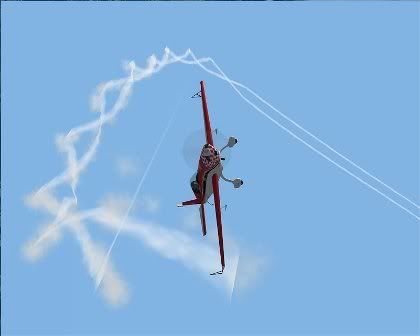I rocked up at the airport to find a TV camera and loads of police wandering around. At first I thought it might be some sort of minor VIP arriving, but as I was checking the plane out, three police wandered past airside, so I asked them what was going on – ‘There’s a protest at the proposed runway extension and we think they might try a runway incursion’. What? All because Gloucester are extending the runway by some 20 metres and bulldozing the house at one end of the runway so they can get back some of the displaced threshold? Just how wrong can local NIMBY’s and so-called environmentalist’s get their facts? The will never be any 737’s in garish orange livery at Gloucester – chill! The runway is simply and never will be long enough!
Anyway, I check the plane and despite a clear note in the booking folder to leave it half-full maximum, some ‘helpful’ joker had filled it to the brim, thus making it too heavy for controlled aerobatics. I met Max and gave him the bad news, but he took it well – and in his finest Gloucestershire burr said ‘I knew that would happen sooner or later – but that’s OK, we can do spinning instead’. Apparently, the Robin won’t spin with less that ¾ of a tank.
So I had a good briefing from Max. The Robin is apparently very marginal and very hard to spin properly, so far so good I guess? Then he goes on to explain ‘…..and if you DO get it into a spin and hold it in for more than three rotations, the engine cuts out, so you have to exit the spin and restart the engine’!!!! Uhhhh – is it just me or doesn’t that sound too good? ‘Oh, it’s no problem, just press the restart button and it gets going again fine’. Yeah right!
So it also spins better to the right than to the left and if you don’t get it right, it will go into a spiral dive – c’mon Max, you’re just trying to cheer me up now!
So we go through the spin entry, which is power to 1800 and pull back in classic ‘slow flight’ manner until the stall warner, then progressive right rudder and pull fully back and away she goes. Hold it in the spin with rudder and back pressure, then recover on his command, probably after two rotations so the engine doesn’t cut by power off, then full (or near full) opposite rudder and unload the back pressure on the stick to neutral – wait for the spin to stop then pull to level - don’t push forward or you will push it past the vertical. Oh, and look up to the horizon to establish the spin direction, NOT along the line of the nose or you will get a ‘plug-hole’ effect and get mesmerised by the spin. Oh yes, and things will happen pretty quickly.

OK, got all that as I mount up. We trudge out the long march to runway in use 09 and take-off. She flies herself off as I set course to the north east for our favourite stomping ground around Evesham. Climb past the inversion layer at 3500’ to 5000’. A few puffy cumulus along the inversion layer, but some big clearings so no worries.
Usual HASELL checks and Max demonstrates the first one and talks it calmly through. All I can say is ‘Holy cr*p Batman’ as the world rotates rapidly around me with us in a steeply nose down position as I watch the ‘plug-hole effect exactly like he told me not to do – DOH!
‘OK – did you follow all that’ he asks as he climbs back up to height and explains what he did, when and why as I try desperately to clear my head and figure out what the hell happened – my first spin – WOW! ‘OK – do you fancy a go’ he asks about as casually as you would if you had just shown someone something on a spreadsheet! Someone else in the cockpit with a voice very similar to mine answered with a confident sounding ‘Yep – let’s give it a crack eh?’ – can’t have been me, I was still trying to figure out what the hell happened!
So I give it a go. A bit slower and more considered on the controls with a more sluggish entry and exit and some intervention from Max as a result. But I did the right things in the right sequence and even managed to look in the right direction this time, so I get the idea.
Anyway, we do a total of three (or maybe four) to the right then three to the left. I have to say, I really think I got it in the end there and began to lose my fear (but not my respect) for the spin and the recovery.
The cloud is starting to box us in and we are still with ¾ fuel – so no quick aeros, instead a steady crawl back to Gloucester for a standard overhead join for 09. Landed long on the runway (as is normal for 09 – or you have a long taxi to the exit and make the guy behind you go-around).
On taxi past the western apron, I noticed four Cabair DA40’s parked in formation. Max explained that on a day like this, the often sent studes out for their QXC one behind the other, so they could ‘follow’ each other on the radio.
Taxi in and shut down. Debrief was good. I really think I got it then and look forward to getting back to ‘normal’ aerobatics next time. But I have to say, I managed to get a nice headache and was wired on adrenaline for the next three hours. Spinning is pretty terrifying at first, but once you have got the hang of it, it’s just another aerobatic manoeuvre, albeit one that chews through the altitude.
Wow – really enjoying this stuff!!!
